Regarding your photographic projects surrounding the hunters and the hunted. I understand you are not a hunter. Has the experience of making these pictures changed any preconceptions you had about hunting?
David Chancellor (DC): This was a project that I’d wanted to work on for a long time. I travel a great deal in Africa and kept seeing these ghostly figures of men dressed like trees, sitting in airport lounges with rifle cases bearing ‘firearm’ baggage tags. Too obvious and too old to be soldiers they were attended by eager porters who rushed them through airports and onto light aircrafts knowledgeable of the fact that they could expect a healthy tip if all went smoothly and serial numbers matched documents, and ammunition arrived at the same time as rifle. So who were they..where do they go..and more importantly what did they do once they got there..? Every hunter I spoke to would state ‘hunting and conservation go hand in hand’…that appeared illogical to me. It also seemed illogical that the fee’s they paid to hunt could actually contribute to the conservation of the animals that they actually hunted. In 1989, Campfire was founded to improve relationships between rural Zimbabweans and their environment to create sustainability. Campfire provides incentives to Zimbabweans to preserve wild animals and utilize them as valuable natural resources, in many instances Campfire has changed the relationship between Zimbabweans and their environment. Campfire profits are generated through leasing trophy hunting concessions to foreign hunters, more than 80% of these profits are derived from fee’s paid by foreign hunters for elephant hunts. The meat from the animals is also given to the surrounding villages. Without this financial incentive the animals would undoubtedly be poached. Both Income and information generated from hunting can contribute hugely to the conservation of wildlife, which I know sounds rubbish, and it is exactly what the hunting World shouts but I increasingly believe that they have a point. However, let’s not forget that hunting also has to be closely controlled. There are good and bad examples on both sides.
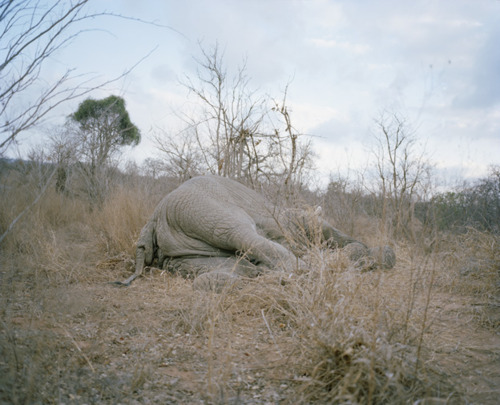
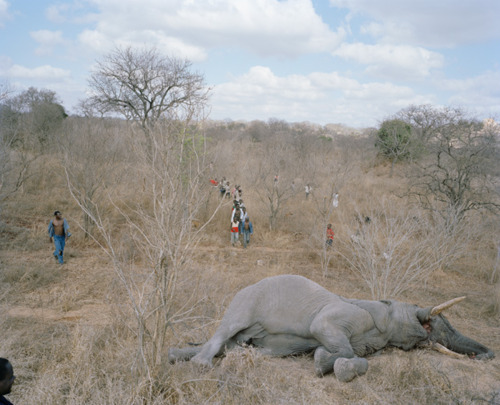
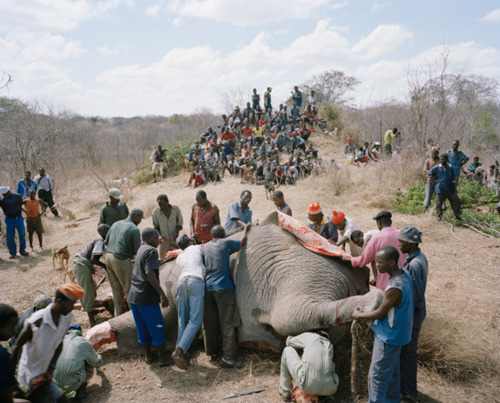

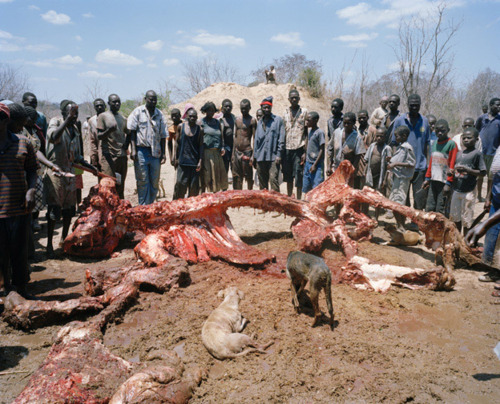
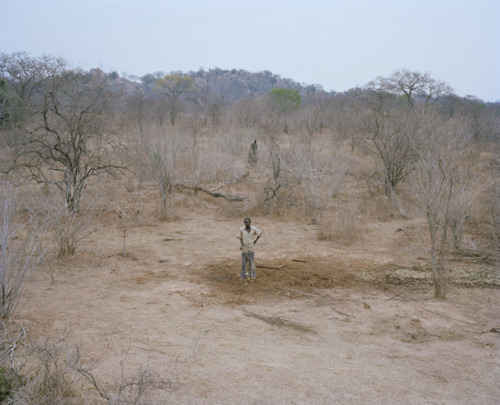
© David Chancellor from the series 'Elephant Hunter'
The artist and diarist Peter Beard made his books, I think, out of a sense that the Wild and Wilderness were notions that were disappearing. Is this something that also interests you in these projects?
DC: It’s not so much the disappearing of environments that particularly interested me with this project, but more the necessity to grasp the reality of the fact that as it disappears we have to maintain an equilibrium. There is no point as Beard illustrated so vividly, in allowing elephants to starve to death because you believe that shooting them is wrong. We have to manage our resources, in Africa that includes iconic wildlife, most of which are considered unacceptable to kill, and particularly eat. Elephant Story was a result of my desire to look at an example of sustainable hunting in Africa, in this case Zimbabwe. Peter Beard is someone who’s work I’ve always admired. In the End of the Game in 1965 he wrote the following: ‘The game is both the hunt and the hunted, the sport and the trophy. The game is killing the game. There was a time when the hunter killed only for his life and food, when wild animals were driven from one area into another instead of being shot or poisoned. Now there are few places left to drive the game. Only 50 years ago man had to be protected from the beasts; today the beasts must somehow be protected from man. The advance of civilisation called for the removal of wild game, the central symbol of African life. One page of game control officer J.A.Hunter’s notebook records the shooting of 996 rhinos. Men acted because they had to, no questions asked. Everything seemed inexhaustible. As boundaries are declared with walls and ditches, and cement suffocates the land, the great herds of the past become concentrated in new and strange habitats. Densities rise, the habitats are diminished, and the land itself begins to die. Imbalance is compounded. The white hunter is still with us, though heavily compromised. Once an explorer, he is now a licensed hired hand whose function it is to keep peace in camp and make sure his clients obtain sizable heads and elephant feet suitable for waste baskets’. So here I was, more than 40 years later, and wondering, where are we now? This was my starting point…
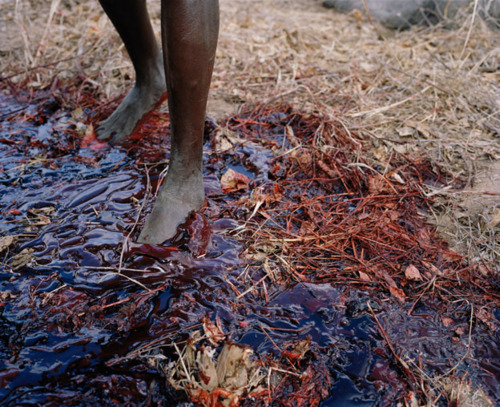
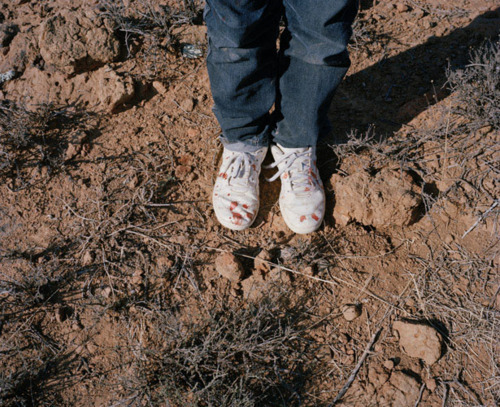
© David Chancellor from the series 'Hunted'
The woman hunters and the men are presented with a very different relationship in gesture and proximity to their kill in your photographs. Can you comment?
DC: The Huntresses I found to be very different to the hunters..much calmer, often sitting with the animal for a long while after hunting it, therefore the resulting portraits are much more contemplative Huntress with wildebeest, Namibia.. . Josie (Huntress with a buck) was 12 years old when I met her. She is from Birmingham, Alabama, USA. She is an experienced hunter, and rider, and had come with her mother and father, also experienced hunters, to South Africa to hunt her first African animal. I spent two days with Josie and her family documenting their hunt This is normally the way I work, it’s hugely time consuming but I learned very quickly that you simply have to be there. The opportunities are brief and intense and it’s impossible to duplicate them later. I’ve worked a great deal with Josie’s professional hunter and he’s comfortable with me being around, and visa versa. I will always explain who I am and what I’m doing and then usually not speak with the hunter again until I see something I want to do, this will usually, but not always be after a ‘kill’. In this case Josie had hunted her buck earlier in the day and was returning to camp, it had been overcast all day and until this point I’d been particularly uninspired by what I shot and very aware of the fragility and beauty of Josie and the passing of light and with it opportunity. I had shot a tracker with a buck previously in this location, also on horseback, that worked but I felt Josie would be much stronger, there was a vulnerability and yet also a strength that I wanted to explore so we headed to the same location and as we arrived the sun set below the cloud cover and for approx 1 minute I had almost unreal light. The ‘pose’ is pretty much Josie’s, I don’t really think she was even aware of how she looked. I will control the situation if I need to, there is usually so much adrenalin pumping through the hunters veins particularly with dangerous game that I have to, on this occasion I didn’t need to do much, the contrast between the peace and tranquillity of the location, the ethereal beauty of Josie, and the dead buck was what I wanted to explore. The horse is significant in as much as it allowed her to sit in an elevated position, grand and statuesque evoking the iconography of the goddess Diana who was often portrayed in mythology accompanied by a deer…
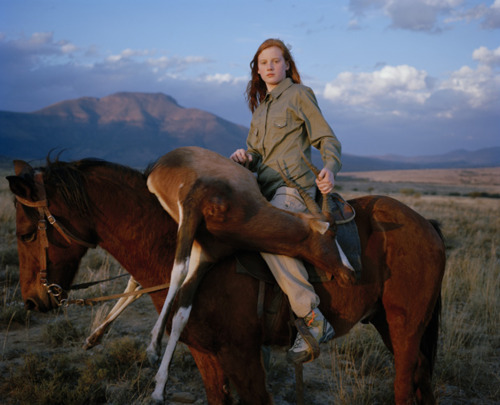
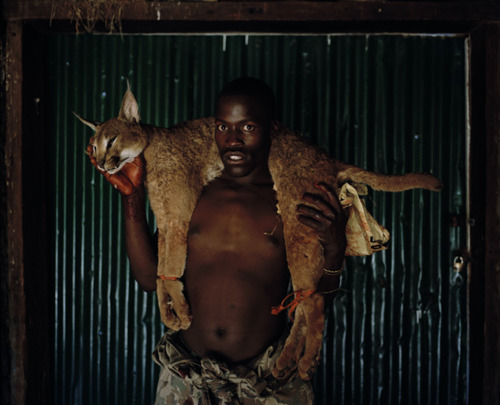
© David Chancellor from the series 'Hunters'
Would you consider your work to be documentary or more as a personal statement?
DC: I’m a documentary photographer first and foremost, I choose to work primarily in portraiture within that genre, my work is and has always been a mixture of documentary, and portraiture. In some cases the surrounding environment is as interesting as the subject itself, so I very much wanted to include that work in this series for example: Giraffe # I, from the series and Rhino with beach towel # II, from the series. However, as I said earlier, my interest is really the hunters, not the hunted. My aim was not necessarily to ‘document’ the industry as a whole, but rather to portray the hunters themselves. I’m not a hunting enthusiast, I’m a photographer, a very recent observer of the industry and I’m deeply convinced by what I’ve seen that it is only by dialogue and understanding that a sustainable harmony between nature and mankind can be forged. The relationship between man and animals is hugely complex and we’re both struggling to adapt to our changing environments. Hunting is an emotive subject, and in pretty much all its forms graphic, that’s obviously another reason I chose to work on it; it can be toweringly beautiful, and painfully raw at the same time, but that is hunting whether it be by man, or a pack of lions.
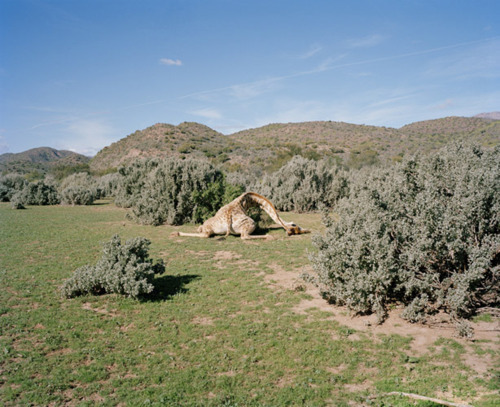

© David Chancellor from the series 'Hunted'
Because of your approach to the subjects I associate many of the hunter photographs with the idea of masks and ritual. Is this something you are thinking about?
DC: There is a tradition in Africa that when a hunter shoots their first animal they get blooded, those portraits are also included in the series. This I felt was an opportunity to explore mans close proximity to animals, Bloodied Hunter # IV, south Africa, here is a boy who clearly stepped from his game boy, and into the bush, this experience was without doubt something that parents felt their children would benefit from, and they regarded as a rite of passage, which I’ve also explored through other projects (Boxers,Umkwetha).
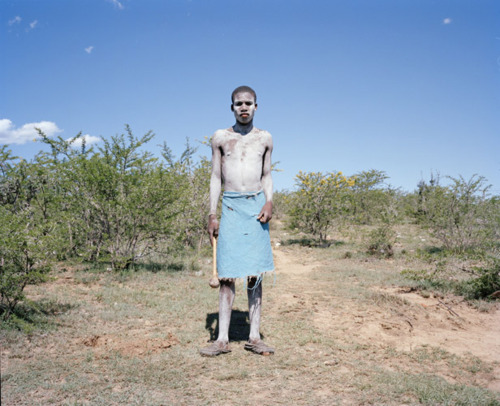


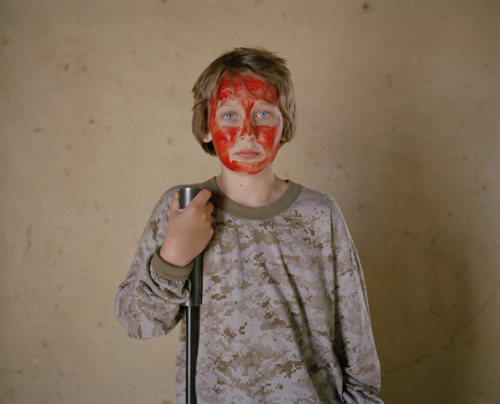

© David Chancellor from the series 'Hunters'
Were most hunters that you approached happy to collaborate with you on these photographs?
DC: I’ve been physically shooting this project for two years, and working on it for more than 3 years, so I’ve met a lot of hunters during that time. Some of them immediately leave a mark on you, others take a while, but all of them are noteworthy in some way or another. Obviously hunting dangerous game requires a certain ‘steel’, portraying those hunters takes time, an elephant hunt for example is usually +/- 10 days camping out in the bush, so by the end of it you know a lot more about the individuals than you did when you set out. I make contact with them a long while before I meet them, by which time they have agreed to my presence, or simply said no, which does happen a lot, but that’s fine. Saying yes, and then not being happy with my presence, or worse still trying to control my work would be a bigger issue…
---
LINKS
David Chancellor
England
share this page